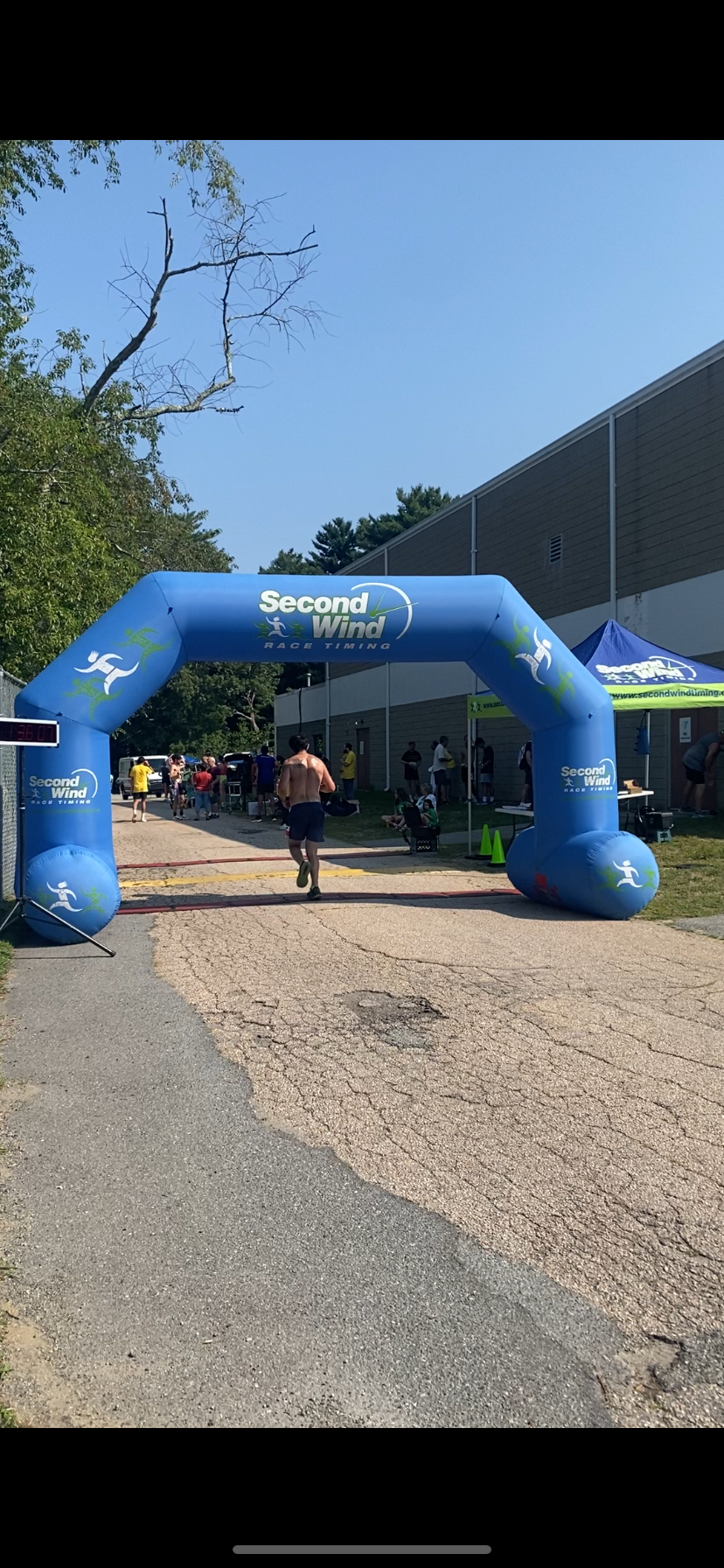Race Report– 08.03.25
Funky Monkey Half Marathon
Distance: 13.1miles | Total Time: 01:36:08 | Pace: 07:20/mi | Elevation Gain: 397ft | Place: 23rd Overall, 7th Male 20-29
This past weekend, I ran the Funky Monkey Half Marathon in Seekonk, Massachusetts. Currently training for a larger event (I’ll keep y’all at the edge of your seats to see what it will be), I took this half as an opportunity to test new race day routines that I’ve discovered during my current running training as a Type-1 Diabetic.
Finsihing the Funky Monkey Half Marathon
Running with a Higher Heart Rate–
Bare with me here… a faster speed means a higher cardiovascular output, which means a higher heart rate, which means higher stress hormone release, which means a higher blood glucose level. Does that make sense? Didn’t to me at first either.
Prior to this training, I’ve been used to running and hiking long distances at a relatively slow speed. In the past, I’ve found that the longer I go, the more carbohydrate resources I burn. This then forces me to refuel with food and electrolytes to prevent hypoglycemia. Now, running at a faster speed (between 06:34/mi-07:45/mi pace), I discovered that my blood sugar does not decrease with the mileage, yet increases. Previously, during runs, my heart rate would set between 140-150bpm (beats per minute). During this half-marathon race, I held an average heart rate of 167bpm.
*More on my blood sugar levels below.
The Caffeine Effect–
Listening to a Huberman Episode on the effects of caffeine on the body (one day Andrew Huberman will read a blog, listen to a pod, and watch a doc– he will then invite me on his podcast, and we will become good friends– I already see him as a good friend even though he has no clue who I am), in lead up to this race, I conducted a 48-hour Caffeine Fast. Essentially, as a high caffeine user (dare I say addict), withholding caffeine for 48-hours and then having it on the morning of the race would enhance the use of caffeine, providing a mental and physical performance boost.
Those 48-hours were the longest and most painful of my life (and I lived through ketoacidosis). I found myself sluggish with a headache up until my first sip on the race morning…
BOOM– this trick totally worked. Although those 48-hours literally slowed down my perception of time and increased my perception of being cranky, once I had the caffeine on the morning of the race, I mentally and physically felt locked in– ready to go. One aspect that I did learn was that this, along with my adrenaline boost, did raise my blood sugar prior to the gun going off.
Katerina & I before the race– smiling because I just had my coffee
Heavy Training Load–
Because this event is part of a larger training, I came into the race already exhausted. I wanted to. My attempt was to push myself as hard as I possibly could after having a tough week of pushing myself. I did not do a proper taper leading up to this race. Instead, by the time the race morning came around, I had already run and walked 20+ miles throughout the week before the 13.1-miles I was about to do. I found that my body was sore before, during, and after this race.
To me, this was a good opportunity for my mind to face off against physical pain. Although my timing may have suffered a little, I am glad I was able to test my body during exhaustion.
Technology is Great until it’s Not–
As Type-1 Diabetics, we rely on technology for proper management. I understand that technology can be unreliable, and therefore as T1Ds, we should always have backup plans in case it fails.
But… what if we don’t know it’s failing?
From constantly training for something, even though my body is ever-changing, I learn routines to best optimize my blood sugar results. For example, if I am on a 10-mile run, and at 3-miles my blood sugar is at 100mg/dL dropping, I know I can eat 24g of carbs (electrolyte blocks) to sustain me for at least 3-4 more miles. Throughout each mile, I can see what my blood glucose is doing and react accordingly.
This was the case with the 13.1-mile race. I started the race at 150mg/dL, and then I ate a banana in hopes that I wouldn’t have to refuel at all during the run. But, at 5-miles, my CGM indicated that I was around 110mg/dL and dropping. From my past runs, this made little sense to me because this is the point where the banana is supposed to keep me level at around 150mg/dL. Trusting my CGM, and knowing I had a full 8.1-miles left, I ate 48g of carbs to boost me up for the rest of the race.
After a few miles, my CGM indicated my levels were dropping again– at this point, around 120mg/dL. Then, my CGM went into an error. Concerned, I slowed my pace to manually check my blood glucose on the run. Pricking my finger on the run is a new practice I’ve been attempting. While I can successfully accomplish it, my pace slows down by 15-30seconds (which isn’t too bad of a sacrifice to make sure you’re alive). My glucometer read 300mg/dL– which is the highest I’ve been in over a year. Two miles later, I tested it again with a reading closer to 200mg/dL. My CGM at the moment was going in and out of consciousness (erroring) with readings around 130mg/dL– clearly way off.
I felt queasy and physically shot at this point in my run– around 9-miles in. Nonetheless, I figured that my levels weren’t dangerously low, and I had plenty of basal insulin in me, so I decided to use the excess glucose in my brain to power my “mind over body” thoughts. I pushed through. After the race, my CGM nearly failed. My levels skyrocketed to the high 300s, and I entered my standard protocol to patiently provide a correction bolus.
Ironically, this all made sense– my stress was high, I ran with a high heart rate, I had a large amount of caffeine intake, I had tons of sugar from the banana to the gels, etc. The one aspect that didn’t match was the technology, and I trusted that technology more than the data I’ve been gathering during training.
Luckily, I landed the plane within two hours, de-escalating down to 90mg/dL, and staying around there for the rest of the day. I changed my CGM sensor, and this new one has been accurate since.
This situation taught me two things:
Technology is great, and I am very appreciative of the accuracy it gives me most of the time, but I must also trust my body and always cross-verify, especially on a performance day. My body is extremely lean and muscular, with little fat. Unfortunately, CGMs in 2025 operate on subcutaneous fat, which I have less of. While I see great accuracy most of the time, there are moments when I see inaccuracy or errors. Hopefully, this can be an opportunity for CGM manufacturers to discover more pinpointed methods of gaining accuracy for T1Ds who are extremely active.
If I can run 13.1-miles at a 07:20/mi pace with blood sugar in the 300s after running 20+ miles earlier in the week, then my body is capable of more if I provide it with optimal conditions.
Pushing through the final steps to the finsih line
All in all, I saw this Funky Monkey Half Marathon as a success. This showed me what went right and reminded me how to handle situations when they go wrong. Through and through, I did not stop and I did not give up.
As T1Ds, I believe it is important for us to learn how to manage as opposed to stopping or using glucose levels as a reason to prevent us from doing things (obviously within margin of safety).
This race is in the books, and this week I am back to the grind of training. Stay tuned!
Katerina ran the 10K at the same time and crushed it. She came in 2nd for her age group! Female 20-29
Those who live with us T1Ds are also affected by the condition even though they don’t have it. They see it every day with us, and they live it every day with us. Their support is crucial to our well-being. So, we must always return the favor and support them with our fullest hearts.
I hope this helps. Stay strong. Stay determined. T1Determined.



